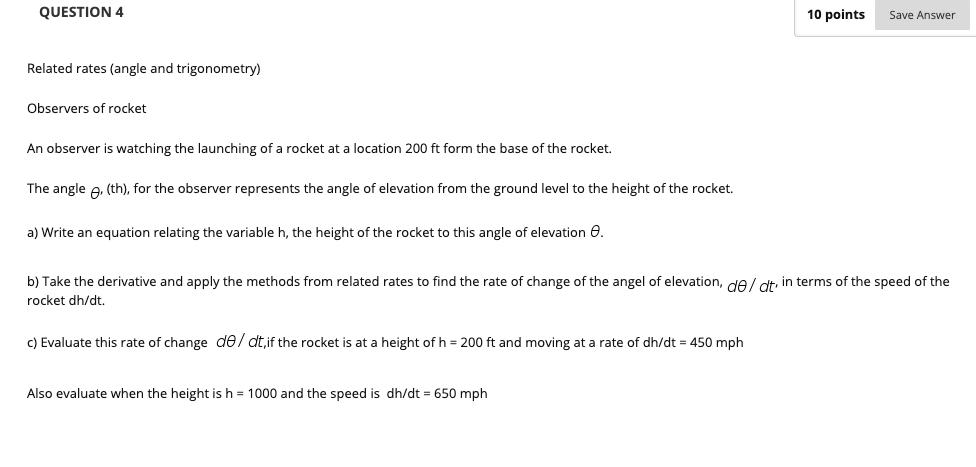Answered step by step
Verified Expert Solution
Question
1 Approved Answer
1. equation for relation (x2 + 4) y? = 8 %3D { (x^2 + 4) y^2 = 8 } a) Differentiate implicitly to find




1. equation for relation (x2 + 4) y? = 8 %3D { (x^2 + 4) y^2 = 8 } a) Differentiate implicitly to find (dy/dx). Evaluate at the point (2,1). b) Give the relation for the corresponding inverse { x y } Then differentiatie implicitly to find the derivative of this inverse. Also evaluate at the corresponding point (2,1) {smmetric about y=x). c) Also observe the relation between these derivatives QUESTION 3 10 points Save Related Rates (Speed of Plane) An airplane is tlying at an altitude of 6 miles and passes directly over a radar antenna (based on same figure used in class, and also found in the textbook). When the plane is 10 miles away, the radar detects the distance s is changing at a rate of 520 mph. How fast is the plane actually travelling at that point in time? (Find dx/dt.) QUESTION 4 10 points Save Answer Related rates (angle and trigonometry) Observers of rocket An observer is watching the launching of a rocket at a location 200 ft form the base of the rocket. The angle A. (th), for the observer represents the angle of elevation from the ground level to the height of the rocket. a) Write an equation relating the variable h, the height of the rocket to this angle of elevation 0. b) Take the derivative and apply the methods from related rates to find the rate of change of the angel of elevation, de /dt, in terms of the speed of the rocket dh/dt. c) Evaluate this rate of change de/ dt,if the rocket is at a height of h = 200 ft and moving at a rate of dh/dt = 450 mph Also evaluate when the height is h = 1000 and the speed is dh/dt = 650 mph 1. equation for relation (x2 + 4) y? = 8 %3D { (x^2 + 4) y^2 = 8 } a) Differentiate implicitly to find (dy/dx). Evaluate at the point (2,1). b) Give the relation for the corresponding inverse { x y } Then differentiatie implicitly to find the derivative of this inverse. Also evaluate at the corresponding point (2,1) {smmetric about y=x). c) Also observe the relation between these derivatives QUESTION 2 Derivative for inverse function Apply the following formula for the derivative of an inverse function to compute the given deriative at the given point. Also illustrate the relation graphically. Y (b) = 1/f(a) { [FM(-1)I'(b) = 1/f(a) where ( f(a) = b; f^(-1) (b) = a a) Apply this formula to compute -1r (b) = 1/f(a) for the following function f(x) f(x) = x-3 + 4 where b = 6. [f^(-1)]' (6) } where { f(x) = sqrt(x - 3) + 4 b) Sketch the gaphs of both f(x) and f^M-1) (x) and describe the relation between them. Also include the tangent lines to each (corresponding to part a)) and give the relations between these. (How is this relation used in the formula above?) QUESTION 4 10 points Save Answer Related rates (angle and trigonometry) Observers of rocket An observer is watching the launching of a rocket at a location 200 ft form the base of the rocket. The angle A. (th), for the observer represents the angle of elevation from the ground level to the height of the rocket. a) Write an equation relating the variable h, the height of the rocket to this angle of elevation 0. b) Take the derivative and apply the methods from related rates to find the rate of change of the angel of elevation, de /dt, in terms of the speed of the rocket dh/dt. c) Evaluate this rate of change de/ dt,if the rocket is at a height of h = 200 ft and moving at a rate of dh/dt = 450 mph Also evaluate when the height is h = 1000 and the speed is dh/dt = 650 mph
Step by Step Solution
★★★★★
3.53 Rating (184 Votes )
There are 3 Steps involved in it
Step: 1

Get Instant Access to Expert-Tailored Solutions
See step-by-step solutions with expert insights and AI powered tools for academic success
Step: 2

Step: 3

Ace Your Homework with AI
Get the answers you need in no time with our AI-driven, step-by-step assistance
Get Started


